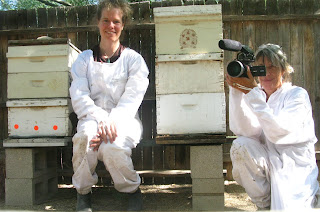
Carolyn Niethammer has a wonderful blog - Carolyn's Southwest Kitchen - that compliments her FABULOUS new cookbook! I got to be a guest blogger this week. So very many thanks to her for asking me to contribute!
Photo: AZPM
Tohono Chul Park's exhibit Día de los Muertos show cases a versatile array of art works created by regional artists paying homage to this observance. Sculpture by Hank Tusinski
A new exhibit at Tohono Chul Park pays homage to the Mexican holiday Dia de los Muertos. It brings together an eclectic collection of regional artists and illustrates the deep influence that this cultural tradition has had on artists north of the US-Mexico border.
The exhibit, although inspired by this uniquely Mexican tradition, illustrates the very personal ways that individuals deal with death, says Ben Johnson, Curator of Exhibitions at Tohono Chul.
“Dia de los Muertos is a holiday of remembrance, but it’s not one that is full of sorrow,” says Johnson. “Dia de los Muertos is very much about family, very much about celebrating life, and offering thanks to those we have loved and missed, and inviting them back into this world to partake in the delights of the living once again.”
Jennie Eschedor has several of her works on display at the exhibit. She says she has been deeply influenced as an artist by the traditions associated with Dia de los Muertos, and she notes that she’s become more comfortable exploring themes of life and death as a result.
“Growing up in Ohio, I was definitely raised to fear death,” Eschedor says.
Eschedor’s work is infused with the iconic images of the Mexican holiday, and incorporates relationships between the seasons, life cycles in nature, and the stages of a human life. She admits she’s felt conflicted about appropriating the cultural traditions of another community.
“Especially since it’s tied into a religion,” Eschedor says. “It makes me hesitant to go in and skim off the top – take the parts I like and leave the rest. The truth of it is that I think it’s just a different way of viewing death, and integrating it more into life. Making it more of celebration is a healthier way to deal with death than to fear it.”
Celebration is a common theme for many of the artists represented in the exhibit, and Linda McKittrick’s work celebrates the life and death of the honeybee. She points out bees are an essential pollinator, but colony collapse disorder has been decimating populations around the world.
“Many beekeepers lost huge numbers, up to 80 percent,” McKittrick says. “I felt kind of a kinship, since I love bees so much.”
McKittric is an artist with a keen interest in bees, but she’s also an urban beekeeper interested in developing sustainable food systems, and working to ensure the health of our ecosystems. She says colony collapse disorder only occurs with bees used in monoculture, and industrialized agriculture – not with bees exposed to a diversified food-source.
“I think some of the monoculture also needs to die,” McKittric says. “There are multiple layers to [my work.]”
MkKittrick’s work takes the themes of Dia de los Muertos and applies them to the modern life and death narrative of the European honeybee. It’s a very personal view of death, and like much of the other work on display at this exhibit; it is inspired by cultural traditions from south of the border.
The Día de los Muertos exhibit runs from Sept. 1 through Nov. 6, with an opening reception during Park After Dark, Oct. 21, from 5 to 8 p.m.
